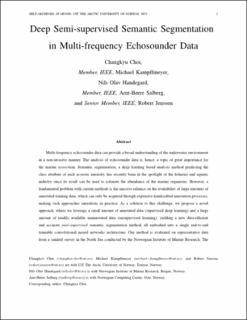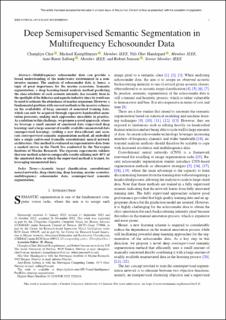| dc.contributor.author | Choi, Changkyu | |
| dc.contributor.author | Kampffmeyer, Michael | |
| dc.contributor.author | Jenssen, Robert | |
| dc.contributor.author | Handegard, Nils Olav | |
| dc.contributor.author | Salberg, Arnt-Børre | |
| dc.date.accessioned | 2023-02-07T09:51:28Z | |
| dc.date.available | 2023-02-07T09:51:28Z | |
| dc.date.created | 2023-02-01T15:00:27Z | |
| dc.date.issued | 2023 | |
| dc.identifier.issn | 0364-9059 | |
| dc.identifier.uri | https://hdl.handle.net/11250/3048794 | |
| dc.description.abstract | Multi-frequency echosounder data can provide a broad understanding of the underwater environment in a non-invasive manner. The analysis of echosounder data is, hence, a topic of great importance for the marine ecosystem. Semantic segmentation, a deep learning based analysis method predicting the class attribute of each acoustic intensity, has recently been in the spotlight of the fisheries and aquatic industry since its result can be used to estimate the abundance of the marine organisms. However, a fundamental problem with current methods is the massive reliance on the availability of large amounts of annotated training data, which can only be acquired through expensive handcrafted annotation processes, making such approaches unrealistic in practice. As a solution to this challenge, we propose a novel approach, where we leverage a small amount of annotated data (supervised deep learning) and a large amount of readily available unannotated data (unsupervised learning), yielding a new data-efficient and accurate semi-supervised semantic segmentation method, all embodied into a single end-to-end trainable convolutional neural networks architecture. Our method is evaluated on representative data from a sandeel survey in the North Sea conducted by the Norwegian Institute of Marine Research. The rigorous experiments validate that our method achieves comparable results utilizing only 40 percent of the annotated data on which the supervised method is trained, by leveraging unannotated data. The code is available at https://github.com/SFI-Visual-Intelligence/PredKlus-semisup-segmentation. | |
| dc.description.abstract | Deep Semi-Supervised Semantic Segmentation in Multi-Frequency Echosounder Data | |
| dc.language.iso | eng | |
| dc.subject | Deep learning | |
| dc.subject | Deep learning | |
| dc.subject | Artificial Neural Networks | |
| dc.subject | Artificial Neural Networks | |
| dc.subject | Nevrale nettverk | |
| dc.subject | Neural networks | |
| dc.subject | Semi-supervised deep learning | |
| dc.subject | Semi-supervised deep learning | |
| dc.subject | Marine acoustic data analysis | |
| dc.subject | Marine acoustic data analysis | |
| dc.subject | Marinteknologi | |
| dc.subject | Marine Technology | |
| dc.subject | Datasyn | |
| dc.subject | Computer Vision | |
| dc.title | Deep Semi-Supervised Semantic Segmentation in Multi-Frequency Echosounder Data | |
| dc.title.alternative | Deep Semi-Supervised Semantic Segmentation in Multi-Frequency Echosounder Data | |
| dc.type | Peer reviewed | |
| dc.type | Journal article | |
| dc.description.version | submittedVersion | |
| dc.description.version | submittedVersion | |
| dc.description.version | submittedVersion | |
| dc.subject.nsi | VDP::Algoritmer og beregnbarhetsteori: 422 | |
| dc.subject.nsi | VDP::Algorithms and computability theory: 422 | |
| dc.subject.nsi | VDP::Algoritmer og beregnbarhetsteori: 422 | |
| dc.subject.nsi | VDP::Algorithms and computability theory: 422 | |
| dc.subject.nsi | VDP::Algoritmer og beregnbarhetsteori: 422 | |
| dc.subject.nsi | VDP::Algorithms and computability theory: 422 | |
| dc.subject.nsi | VDP::Algoritmer og beregnbarhetsteori: 422 | |
| dc.subject.nsi | VDP::Algorithms and computability theory: 422 | |
| dc.subject.nsi | VDP::Algoritmer og beregnbarhetsteori: 422 | |
| dc.subject.nsi | VDP::Algorithms and computability theory: 422 | |
| dc.source.journal | IEEE Journal of Oceanic Engineering | |
| dc.identifier.doi | 10.1109/JOE.2022.3226214 | |
| dc.identifier.cristin | 2121874 | |
| dc.relation.project | Norges forskningsråd: 270966 | |
| dc.relation.project | Norges forskningsråd: 309439 | |
| dc.relation.project | Norges forskningsråd: 309512 | |
| cristin.ispublished | true | |
| cristin.fulltext | preprint | |
| cristin.fulltext | preprint | |
| cristin.fulltext | preprint | |
| cristin.qualitycode | 1 | |


